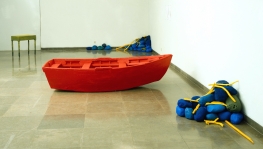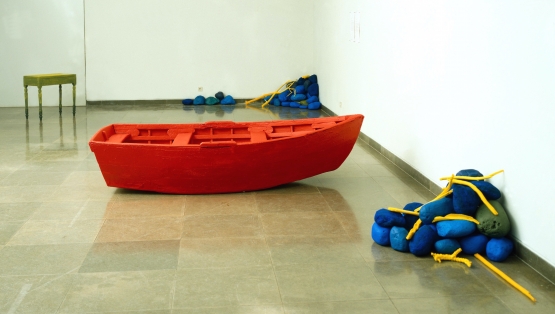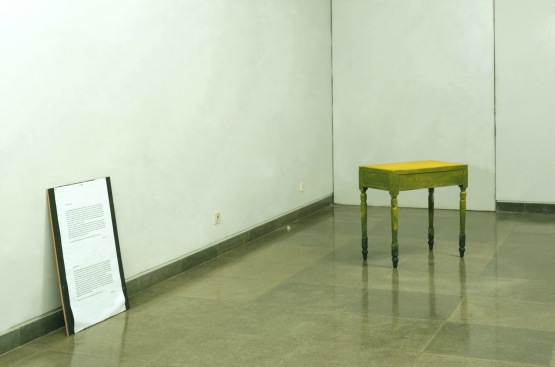Paralaxe, Points of View and a Drifting
Pedro Lapa
This installation by Jimmie Durham had its starting point in a memory of the collection of paintings in the Museu do Chiado, particularly within its nineteenth century nucleus, which is clearly of a regional tendency and is assymetrical towards international modernity. However, there is no direct allusion to this nucleus which might imply a profound knowledge, but this work is not de-contextualized and indifferent to possible issues which a visit to this museum might give rise to. Or rather, if we wish to describe the process, this work starts from a dream of the artist's which transfigured the memory he had of a handful of paintings. "Interruptions" thus configures the dislocation to which a set of signs is subjected by a point of view, which does not intend to be the depicting of a certain historical context, but the drift promoted, which is openly subjectively, historically and culturally exterior. This fact valorizes the temporal contingency as a strategy of reflection.
Thus, at first sight, the elements which make up this installation - the boat, the stones, the remains of wood and floating sticks - appear as a traditional painting, with the particular aspect of it being inhabitable. However, the table introduces a discreet note of discordance within this environment, and, especially, juxtaposes something which is not directly related to it. All these elements are painted in bright acrylic colors, and their scheme of relationships is completely different to that of the plastic references towards which the typology of the elements seems to point, in this way creating a further dislocation. The visitor may go through this painting in its three dimensions and verify how its referents are not represented, but are transformed by the very painting which covers them and reveals them as pictorial signs. For this reason the sign does not represent its referent, which would be characteristic of the understanding of a naturalistic painting, neither is the referent purely and simply dislocated through a linguistic operation, or nominalist if one wishes, as if it were a readymade. In this installation, referent and sign cohabit by means of a superimposing, which does no more than reveal how all perception sees the sign as a vestige and inscription of a context, with all of its cultural, political or historical conditionings. The novelty may reside within the fact that these aspects are declared strictly through the superimposing of visual languages, a novelty even within the work of Jimmie Durham, in which these dislocations are normally established through the relationship between text and image. The ambiguity, with which the traditional signs of a cultural situation are launched, questions their role as agents of a field of identity to which they aim, through the contrast and transformation of the visual field which they have undergone. The dislocation of a historically consigned visual scheme to another which is alien, different in culture and time, is introduced by the pictorial reconfiguring of all the elements with in the set, and functions without a direct recourse to verbal language. Consequently, it only implies this.The circuit between visual and verbal language, which is often recurrent in many of the artist's works, is thus interrupted within these "Interruptions". Not that the texts are not a part of the whole; that which is irradicated is their hegemony in relation to the image. The possibility of them becoming explicative and re-codifying of the visual signs, granting them normative identities, would block the differences within a binary and totalizing scheme. For this reason the texts present an irreducible difference in relation to the other visual elements. That which the latter promote is a diversity of contexts which are concomitant with the issues raised by the former. Thus the dictionary of Porepecha-Portuguese, hanging from the ceiling, at the beginning of the path through the installation, works as a sign of translation, and, after having been read, is still enigmatic, as linguistic translation is of little help to us in understanding the games, the emotions or the concepts of a different cultural context. In parallel, something similar takes place with the visual elements which are translated from one time to another and remain disjunctive. Another text, "A Bem da Nação" * (To the Good of the Nation), nailed onto a wall, brings together, within a free association, a very heterogenous set of readings, news and facts within the same line of discourse organized by the subjectivity of the artist himself. The diversity of motifs finds a common denominator in the several significants of political power, as an exercise in coercion at the expense of any irony. Finally, a text quoting the "Reading of a Wave" from Palomar by ltalo Calvino, aiming at a description which is as complete as possible of the phenomenon, complexifies its possibilities until it declares the object itself as a circumstance. Indeed, it always appears as the moment of a system and as a consequent provoker of multiple points of view.Thus themes such as cultural tradition, political coercion or the complexity of perception and of the object perceived, raised by these texts, may appear close to the issues posed within the visual field and may confront them, yet without restricting their horizons of meaning.
The discontinuity between the objects and the texts which are interposed among them breaks up any unity of the visual or verbal field. The diver se categories of the signs give way to each other through a montage which inhabits the space of the installation of diversified cultural references and dislocates them with consequent changes in meaning and resonances. Within this context, the various cultural origins and differences which coexist overcome the historical mobility of their references, and generate a more productive and critically active horizon.
Time, understood as a contingent inherent to all places, is susceptible to be an instrument which allows the differences which organize the verbal or visual discourses and promotes the critique of a normalizing and hegemonical vision of history itself. In this sense, both the naturalist values, in its anti-modern landscape attitude, and its irremediably peripheral modern transfiguration subjected to the status of a viewer from another world - like the artist who glimpses the world in the text "A Bem da Nação" (To the Good of the Nation) -, become removed from their normative nature and take on a conflictuous mark which generates forms of meaning and of a search for their own narrative or history. In this act, the past is projected and touches the present. There is a breaking of the complicity between them, and there is an opening of a space of revision in which the values which the signs carry are staged and revealed within their implications.
Naturalist painting, in its belief in a visuality which imitates the real, here dislocated and transfigured, reveals a conflicting aspect which is no less than that of Palomar trying to see a wave in Calvino 's text. So this landscape of "Interruptions", set up through some of its signs, which carry their own referents, is possible to be divined, although along with the cultural mechanisms of divination.
* "A Bem da Nação" was a formal expression to start or finish an official document in Portugal during the fascism.












